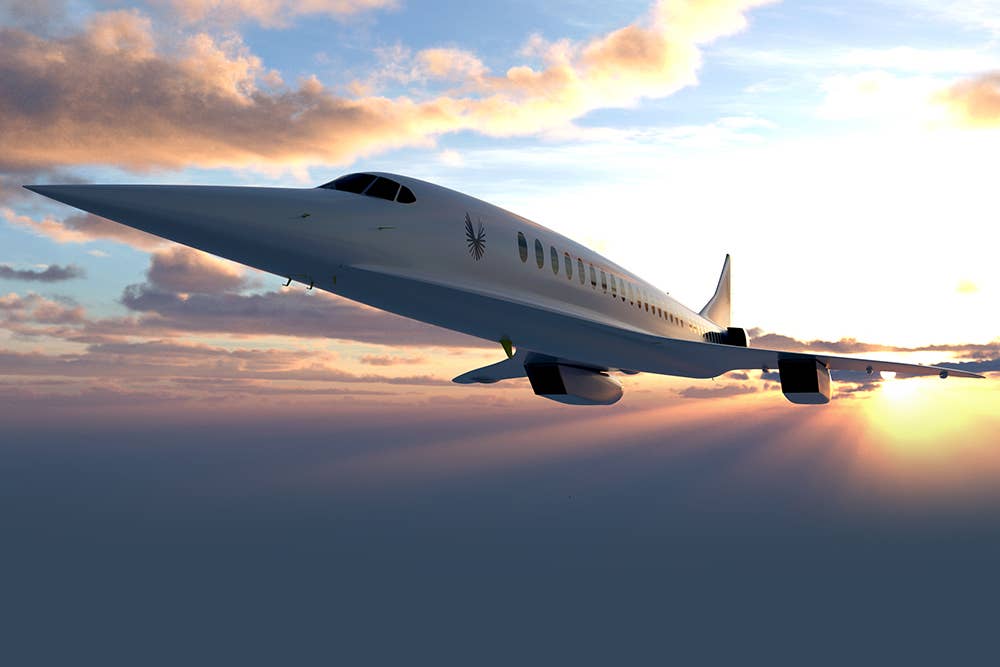Curious About Boom Supersonic? Here Are Five Things to Know
Colorado-based company aims to get passengers in the sky by 2029.

Boom says its Overture jet will be capable of flying on 100% sustainable aviation fuels (SAF). Courtesy: Boom Supersonic
What is Boom Supersonic?
Boom is a Denver-Colorado-based startup founded in 2014 that seeks to build what it calls the world’s fastest supersonic airliner as more companies seek to revive supersonic commercial flight nearly 20 years after the grounding of the Concorde, history’s only successful supersonic airliner.
What is Boom building?
Boom is currently developing its XB-1 supersonic demonstrator and Overture, a 65-88 passenger, Mach 1.7 supersonic airliner. (Concorde boasted a cruise speed above Mach 2.)
The XB-1 shares key technologies with Overture, such as advanced carbon fiber composites and a refined delta wing. Boom will use lessons learned from XB-1 flight testing to help optimize Overture and to prove that in-flight key technologies are safe for efficient travel at supersonic speeds.
The XB-1 was formally revealed to the public in October 2020.
When will you be able to fly in the Overture?
Overture, with an estimated $200 million price tag (plus options and interior)—and a cruising altitude of 60,000 feet—is slated to roll out in 2025, fly in 2026, and carry passengers by 2029, according to Boom.
While the company says final ticket prices will be set by airlines, Overture is being designed “to allow airlines to offer fares comparable to today’s business class. Our long-term vision is that the fastest flight is also the most affordable,” according to its website.
Boom’s founder, Blake Scholl, told The New York Times that the goal is to deliver passengers anywhere in the world within four hours for $100. In comparison, tickets from New York to London aboard Concorde cost thousands of dollars.
Can Boom fly supersonic in the U.S.?
Like the iconic Concorde, the supersonic Overture will only exceed the speed of sound during overwater routes such as New York to London and San Francisco to Tokyo. Decades ago, the FAA banned supersonic flight over the continental U.S. because of the effects that sonic booms can generate.
In January, the FAA announced final rules for supersonic test flights in the U.S. meant to streamline the approval process, which is a key step in ultimately getting a product to market.
While the FAA still prohibits unlimited supersonic flight over U.S. soil, it does provide exemptions for testing, which is good news for Boom.
Who are Boom’s supporters?
In June, United Airlines became the first U.S. airline to sign a commercial agreement with Boom, announcing it plans to buy 15 of the supersonic airliners, contingent on Boom hitting certain milestones.
Japan Airlines has also pitched in $10 million for the development of the airliner and with an option to purchase 20.
Boom is also working with the United States Air Force for government applications of Overture.
Its partners include Collins Aerospace, which is collaborating on the nacelle technology development; Rolls-Royce, which is developing a custom propulsion system; and Amazon Web Services for high-powered computer cloud storage and security.
So far, the company has raised $270 million as of May; its investors include American Express, Bessemer Ventures, Prime Movers Lab, Emerson Collective, and Celesta Capital.

Sign-up for newsletters & special offers!
Get the latest FLYING stories & special offers delivered directly to your inbox






